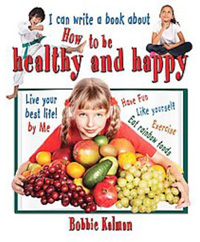| ________________
CM . . . . Volume XIX Number 30 . . . . April 5, 2013
excerpt:
The Crabtree Publishing website claims that author Bobbie Kalman has written over 800 books. Now she has written eight books in the "I Can Write a Book About" series, including the books she refers to in this quotation on page 31. She is certainly qualified to explain how to write a book and maybe you need one – but not this one. Successful 'how-to' books guide you step by step through a process, helping you learn a skill in an engaging but straightforward way. I Can Write a Book About How to Be Healthy and Happy waits until page 16 before it tells you the first step – "Start with an outline". Allowing for the title page, verso and table of contents, that is 12 pages of filler that young readers need to get through before they learn anything about how to write a book. Really successful 'how-to' books fill a need. Pedagogically, it would be better to provide students with access to several examples of nonfiction books and help them discover for themselves the different parts of a book. Guiding them through the steps of writing a book together is sure to produce more meaningful learning than giving them access to this poorly conceived book about how to write a book. This book does not fill any real need. Although the information in the second half of I Can Write a Book About How to Be Healthy and Happy is instructive, it includes too much extraneous material. For example, on the pages about how to create an outline, the author also includes the following information.
While this would be an excellent activity, it is does not help a student learn how to create an outline. The author does not make any mention that the student author/gardener could write about this experience in her/his book. Accompanied by an attractive picture of a girl with a basket of tomatoes, it is just more tangential filler. The topics in second half of the book include "Start with an outline", "How and what to research", "Describe and persuade!", "Revise, edit, proofread", and "Parts of a book", among others. These are topics that will help young authors work their way through writing a nonfiction book. The first half of the book includes topics such as "Healthy and happy you!", "What does your body need?", "'How to cook' words", "How to cook safely", "What is fitness?", and "What makes you happy?" The information in this half of the book is informative on the topic of healthy and happiness, but the minor attempt to link this information with the process of writing a book seems more like Bobbie Kalman self-promotion.
As mentioned at the beginning of this review, the books on page 31 are other Bobbie Kalman books. Kalman also uses another of her books, I Eat a Rainbow, as an example of her own work on the topic of health and happiness:
The photos and illustrations in the book are bright and appropriate with a good mixture of gender and ethnicity represented. It is nice to see a reminder to young authors (and others) to look for pictures on the internet that are free to use. Intellectual property and copyright aren't explained in detail, but readers are reminded: "(w)hen you download a picture, make sure you include the source, or where you obtained, the picture." This book also includes a table of contents, a picture dictionary, a glossary and index. Words that are in bold but explained in the text are not included in the glossary. Although at first glance I Can Write a Book about How to Be Healthy and Happy may look appealing, don't be deceived. Unfortunately, the second half of this book, explaining the process of how to write an instructional book, does not justify adding it to your collection. For reviews of the other earlier books in this series, see CM, Volume XIX, Number 13, November 30, 2012. Not recommended. Suzanne Pierson, a retired teacher-librarian, is currently instructing Librarianship courses at Queen's University in Kingston, ON.
To comment
on this title or this review, send mail to cm@umanitoba.ca.
Copyright © the Manitoba Library Association. Reproduction for personal
use is permitted only if this copyright notice is maintained. Any
other reproduction is prohibited without permission.
NEXT REVIEW |
TABLE OF CONTENTS FOR THIS ISSUE
- April 5, 2013.
AUTHORS |
TITLES |
MEDIA REVIEWS |
PROFILES |
BACK ISSUES |
SEARCH |
CMARCHIVE |
HOME |
